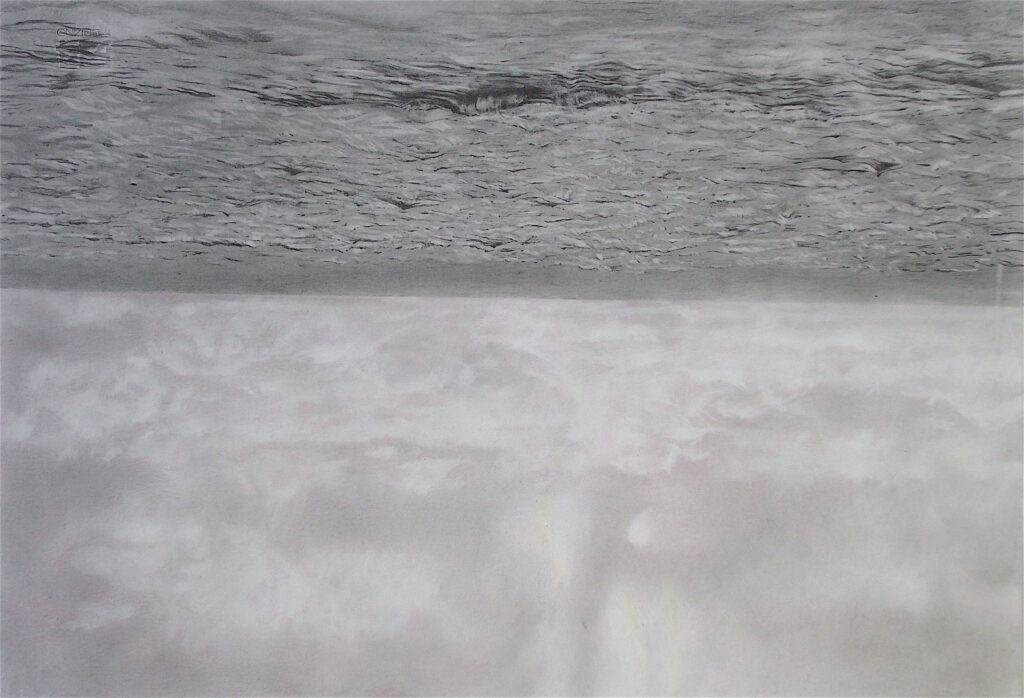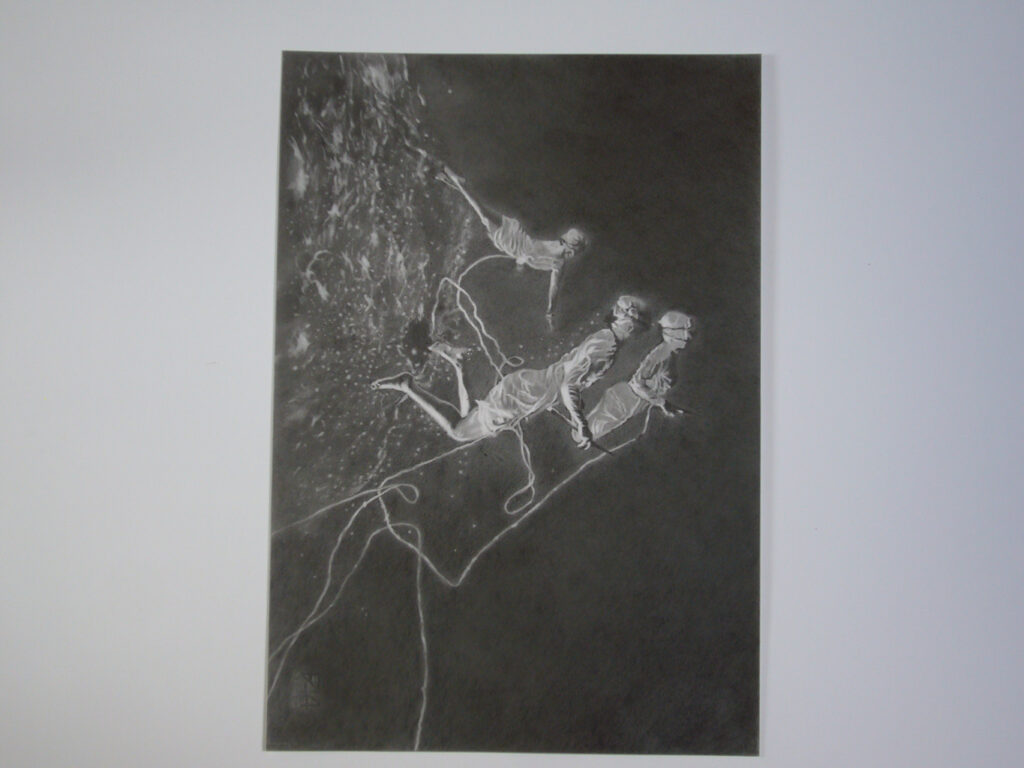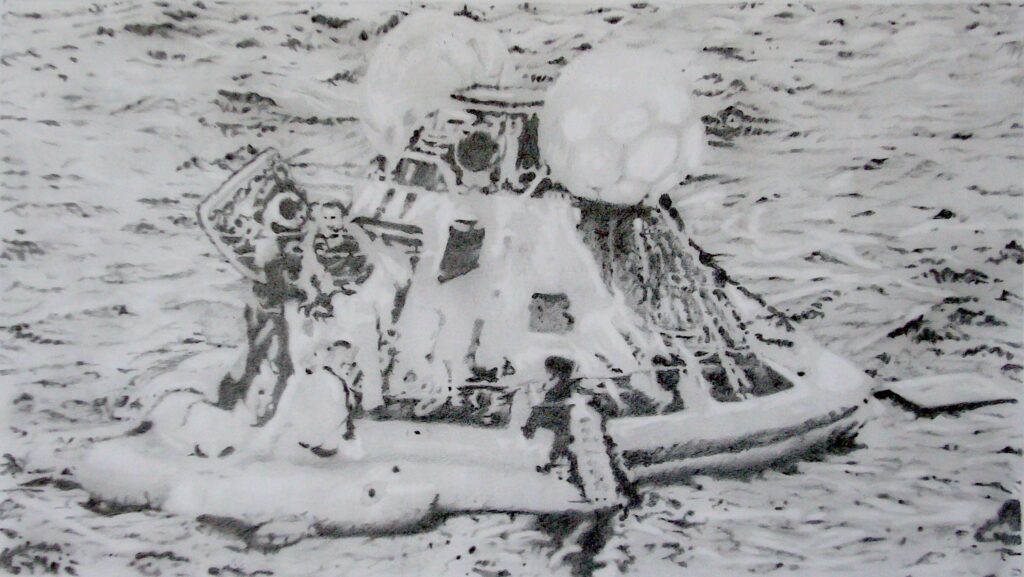Cloud Falls in Love with Mortal
I read somewhere that clouds are sometimes referred to as floating lakes. I’ve been thinking about this idea because it is what I want these drawing fragments to feel like: small worlds held in paper, entire novels condensed into pictures, internal cartographies charted. In this body of work, the real and the imagined, the domestic and the intellectual, and the comic and the trivial, meet on the same plain: the subject may be a much-loved black and white cat that is as worthy of contemplation as a skyscape or an academic text.
James found a cache of Star Trek episode treatments on Ebay and one from a second series episode, Metamorphosis, seemed connected to a proposal I’d made to build a body of work based on a fata morgana mirage. The plan I’d had used an article in The Sun about a rare atmospheric event over the English Channel as the starting point for an exhibition at Hastings Contemporary gallery in 2021. The show will be part of the Evelyn Williams Drawing Prize. The newspaper article showed a fata morgana mirage appearing to open up a portal into a mysterious upside-down parallel world, perhaps one of those worlds described by Philip Pullman and C.S. Lewis. Here is the article: https://www.thesun.co.uk/archives/news/60309/is-that-a-mysterious-floating-city-in-the-sky-above-hastings/
Metamorphosis is an early episode in which the crew are forced to land on a planetoid. Soon after landing they meet a spaceman called Cochrane and an energy cloud called The Companion. The Companion falls in love with Cochrane, eventually shape-shifting to human form to build a life with him out there in the distant reaches of another galaxy. As children, my sister and I liked Star Trek, and this story was one I recognised. My sister is a good mimic, good at scary noises, and she can voice most of the crew of the SS Enterprise, just as she would do at the end of each episode all those years ago when we watched it every week. Even now, my sister will do a spooky impression of The Companion, just to see if I’m still scared by it. Strangely, I no longer find the idea of alien intelligence frightening, rather I’m curious about the way that this episode touches on contemporary conversations about the Anthropocene, and cultural anxieties about planetary collapse.
The Metamorphosis episode returned me to an idea I’d had to make a body of work in a different way than usual. Cloud falls in love with mortal takes the form of a number of connected but separate works that branch off from the idea of the mirage in a kind of aesthetic patterning.
Fata morgana, named for Morgan Le Fay, also known as the green ray is said to represent fate or hope, an optical phenomenon that combines science and myth. Researching the idea of the companion-as-cloud, a strange but sentient shape-shifting amorphous form, I imagined its lineage from Nefele, a Greek cloud goddess, stretching back to Algoanice, a female astronomer from the 2nd or 1st century BC, who could predict the eclipse and claimed to be able to draw down the moon. The last message from the Mars Rover Opportunity provided the source for another work, based on Opportunity’s final communication which starts ‘My battery is running low…’ A telegram message, its source buried deep in an archive, requests radio stations to monitor any unusual electrical phenomenon in the event of attempted communication from Mars.
The work loops, and spills over into new territories. As a part-work it offers a dislocated narrative rather than a story. Narratives unfold intermittently. Every image is tacitly interpreted by the last. The project grows promiscuously, mapping its journey through associative threads, while the spine of drawing holds the different fragments together.
Initially I imagined Cloud falls in love as a more discrete work: a kind of thought-experiment that would explore what drawing might be capable of if I were to really push at it. The problem was, that although I knew my plans would break down, the context of the pandemic meant that different dynamics came into play, the question then was about how to take account of different rhythms of living, reading, working, thinking. I also had broader questions relating to what drawing is like as much as what it does or means (I really wanted to give some kind of felt sense of what it is like to draw). For me, there was also something valuable about accepting a lack of comprehensiveness in my own practice, recognizing the fragmentary, because how could anyone ever claim mastery or true expertise over the phenomenon that is thousands of years of drawing history?
Finally, what I hope is that the project has a quality of compositional satisfaction that makes it work as an experience for other people. I like the idea that its meaning is restless and unresolved. I’m not really convinced by bold certainties – I doubt any artist is.
A clip from the Star Trek episode, Metamorphosis is here: Metamorphosis





















